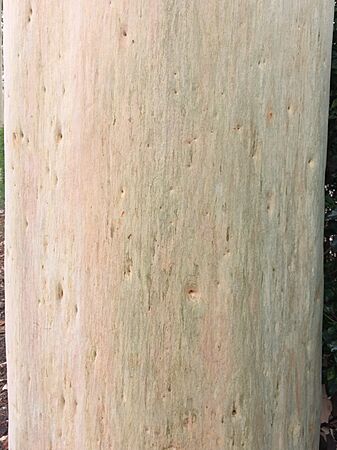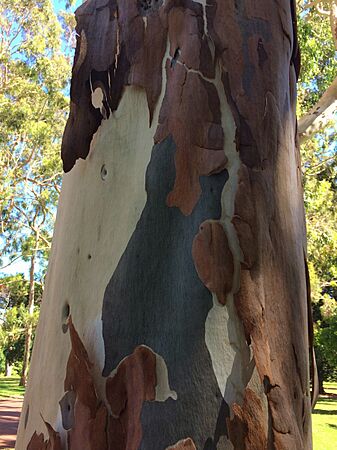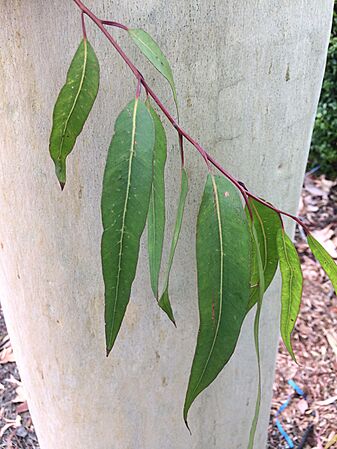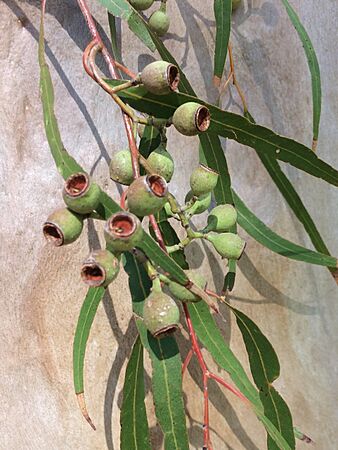Lemon-scented gum facts for kids
Quick facts for kids Lemon-scented gum |
|
|---|---|
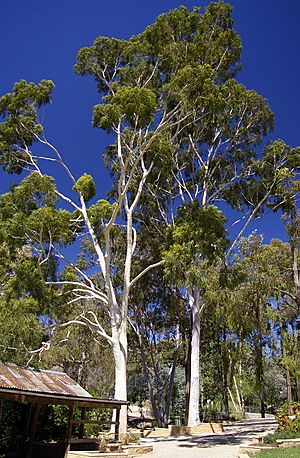 |
|
| Corymbia citriodora in Wagga Wagga Botanic Gardens | |
| Scientific classification | |
| Genus: |
Corymbia
|
| Species: |
citriodora
|
The Corymbia citriodora, often called lemon-scented gum or spotted gum, is a tall tree. It grows naturally only in north-eastern Australia. This tree has smooth bark that can be white or pink. Its leaves are long and narrow, and its flowers are white. After flowering, it produces fruit shaped like an urn or barrel.
Contents
What is the Lemon-Scented Gum Like?
The lemon-scented gum is a tree that usually grows to be 25 to 40 meters (about 82 to 130 feet) tall. Some can even reach 50 meters (164 feet)! It has smooth bark that is pale white, pink, or coppery. This bark peels off in thin pieces.
Young plants have egg-shaped or lance-shaped leaves. These leaves are about 8 to 21 centimeters (3 to 8 inches) long. Adult leaves are shiny green on both sides. They often smell like lemon when you crush them. These leaves are long and narrow, about 10 to 23 centimeters (4 to 9 inches) long.
The tree's flower buds grow in groups of three. They are oval or pear-shaped. The flowers are white and can appear in most months of the year. After the flowers, the tree produces woody, urn-shaped or barrel-shaped fruits. These fruits are about 8 to 15 millimeters (0.3 to 0.6 inches) long.
How Did It Get Its Name?
The lemon-scented gum was first officially described in 1848. This was done by a scientist named William Jackson Hooker. Later, in 1995, two other scientists, Ken Hill and Lawrie Johnson, changed its name to Corymbia citriodora.
The name citriodora comes from a Latin word. It means "lemon-scented," which perfectly describes the tree's smell! This tree is similar to other trees called C. maculata and C. henryi.
For a long time, this tree and many others were part of the Eucalyptus group. But in the 1990s, scientists found that some of these trees, including the lemon-scented gum, were different enough to be in their own group. This new group was named Corymbia. Even though they are now in a different group, many people still call them "eucalypts." This is because they are all closely related.
Where Does It Grow?
The lemon-scented gum grows in open forests and woodlands. You can find it in different parts of Queensland, Australia. It also grows as far south as Coffs Harbour in New South Wales. In Queensland, it's found from Lakeland Downs and Cooktown in the north, to places like Hughenden and Chinchilla inland.
This tree has also been planted in other parts of Australia. For example, it grows in the Darling Range near Mundaring in Western Australia. It has also been planted in suburban areas of New South Wales, South Australia, and Victoria. It likes soils that are a bit sandy and slightly acidic.
There is a famous street lined with these trees in Kings Park in Perth. However, sometimes when a tree is planted outside its natural area, it can spread too much. This can make it a "weed" in new places.
The lemon-scented gum is an important tree. Its wood is used for building. It's also good for making honey. Many people like to plant it in gardens both in Australia and other countries.
What's Special About Its Oil?
The lemon-scented gum produces an essential oil. This oil is mostly made of a substance called citronellal. A lot of this oil is produced in Brazil and China.
The unrefined oil from the tree is used to make perfumes. A special, refined version of this oil is used in insect repellents. It is especially good at keeping mosquitoes away. This refined oil is known by names like "Citrepel" or "Citriodiol." It's also called "oil of lemon eucalyptus" (OLE) in the USA.
Scientists have studied how well this oil works. They found that products made with oil of lemon eucalyptus were good at keeping mosquitoes away from people. The smell of the oil can be strong, similar to citronella oil, but with a hint of lemon.
- Features of the lemon-scented gum (''Corymbia citriodora'')
See also
 In Spanish: Eucalipto olor de limón para niños
In Spanish: Eucalipto olor de limón para niños



